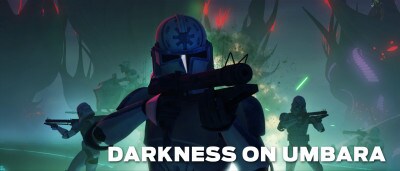Counting down the all-time top installments of Star Wars: The Clone Wars!
Welcome to The StarWars.com 10, a feature where StarWars.com’s editorial staff huddles to discuss -- in a committee -- various topics relating to a galaxy far, far away. Today we're looking at the top installments of Star Wars: The Clone Wars. Note: In the case of story arcs with multiple strong episodes, we opted to select one installment from each.
Ahsoka Tano. Captain Rex. Force gods. It's difficult to overstate all that Star Wars: The Clone Wars brought to the world of lightsabers and blasters. It changed what we thought we knew about Star Wars, from its characters to its politics to the mystery of the Force, and did so with smart, challenging stories of wide-ranging tone. Created by George Lucas and shepherded by Dave Filoni, the animated series contains more than 40 hours of canonical Star Wars content -- a treasure trove for fans casual or hardcore, and perfectly accessible to both. With the show's recent completion thanks to the release of The Lost Missions on Netflix, the StarWars.com team is counting down the top episodes of the series' entire six-season run.
10. "The Zillo Beast," Season Two
Supervising director Dave Filoni is a huge Godzilla fan, and he included many subtle nods (clone pilot Gogi's helmet featuring Godzilla's eyes, etc.) to the giant monster throughout The Clone Wars. "The Zillo Beast" is a not-so-subtle nod. Republic forces drop an electro-proton bomb during a battle on Malastare, unwittingly releasing the towering Zillo Beast creature, whose hide is impervious to lightsabers. The design of the creature is not particularly Godzilla-esque, which is a good thing; it's lanky and graceful with a kind of frightening beauty, differentiating it. But this episode is classic Japanese monster movie stuff -- right down to the Republic's foolish attempts to study the beast -- and it fits surprisingly well in the Star Wars universe.
9. "Wookiee Hunt," Season Three
A monumental episode in marking Ahsoka Tano's growth and maturity. Captured by Trandoshans and hunted for sport, Ahsoka successfully leads a revolt (with an assist from Chewbacca), defeating her kidnappers and killing them when she has to. This episode also raises questions about the Jedi; out of all the captured Padawans, only Ahsoka has the creativity and bravery to stand up to the Trandoshans. Maybe there's something to Anakin's unorthodox ways?
8. "Monster," Season Three
One of the stranger episodes of The Clone Wars, "Monster" changed many preconceived notions about what's possible in the Star Wars universe and set the stage for some major developments. Mother Talzin transforms Savage Opress into a hulking Sith trainee -- in reality, a new kind of Star Wars villain, as he's one that can rely on brute strength. The threat of Talzin and her dark magic also becomes a new element in the saga, and would later come full circle with the restoration of Darth Maul.
7. "Ghosts of Mortis," Season Three
The final installment of a trilogy featuring major revelations about the Force, "Ghosts of Mortis" stands as not just great Clone Wars, but essential Star Wars. Ripples of everything here echo in the series and in the films, from the Son's pontificating to Anakin's visions and a deeper understanding of what the "balance" of the Force really means. Still, there's a thematically tragic, dark hue to this episode, as it's ultimately filled with death and foreshadowing of the impending Sith ascendency to power. In a grander sense, "Ghosts of Mortis" acts to balance the saga itself, reminding us that there are light and dark forces, always, pulling at each other. It's the characters' choices that impact that balance.
6. "Rookies," Season One
One of the big challenges of The Clone Wars was to humanize the clone troopers -- not so easy a task, considering the audience knows they'll ultimately wipe out the Jedi. It's a black cloud that hovers over the series to great dramatic effect, but creates an inherent distrust in the Republic's troops. It's episodes like this that help to accomplish the seemingly impossible goal of making us genuinely like the clones, introducing a group of green soldiers thrust into an impossible situation. Only two -- Echo and Fives -- make it out alive, and it's a testament to "Rookies"'s success that they would go on to become fan favorites. The clone troopers were brave, selfless, and heroic. "Rookies" proves that.
5. "The Box," Season Four
A big video game of an episode, "The Box" sees the galaxy's best bounty hunters in a winner-takes-all competition. Obi-Wan Kenobi is once again playing detective -- one of the best uses of the character, first glimpsed in Attack of the Clones -- this time undercover as bounty hunter Rako Hardeen. He partakes in Count Dooku's bounty hunter test, a series of challenges with escalating difficulty. It's an interesting look into the world and code of the Star Wars underworld, with some of the series' greatest action.
4. "Darkness on Umbara," Season Four
Another great clone-centric episode, "Darkness on Umbara" illustrates the tension, danger, and confusion of war. When Anakin is recalled to Coruscant mid-mission, Jedi General Pong Krell takes over command. Krell is dismissive of his own clone troopers, egotistical, and somewhat heartless. Through the clones, including Rex, Tup, and Fives, we see different opinions and feelings on combat, strategy, and what it means to follow orders. We also see some masterful use of atmosphere and pacing rarely accomplished in an animated series, giving the episode an unnervingly ominous feeling.
3. "Sacrifice," The Lost Missions
A bookend to the Mortis trilogy and a Star Wars masterpiece. Yoda travels the galaxy learning about the Force and about himself, completing a series of quests that reveal major parts of Star Wars lore and deepen what we know from the films. In "Sacrifice," Yoda heads to the Sith homeworld, where he encounters the specter of ancient Sith Darth Bane and, on a mystical plane, does battle with Darth Sidious. From start to finish, the stakes are high and the drama is captivating, on a level with the best moments of the Star Wars movies. Mark Hamill stuns in his cameo as Darth Bane -- he sounds nothing like Luke Skywalker, yet the thematic connection between the two characters is crystal clear and is strengthened by Hamill's presence. The tone of it all is very Revenge of the Sith, right down to the visuals and kinetic duels, but nothing from the film is repeated here. Most significantly, however, it completes Yoda; we see how he goes from the somewhat cold Jedi Council leader who dismisses Anakin's training in The Phantom Menace to the warmer, wiser, more selfless mentor of The Empire Strikes Back. "Sacrifice" is everything that Star Wars is: it's dark, it's light, it's scary, it's hopeful. A fitting last episode.
2. "To Catch a Jedi," Season Five
Part of the killer Season Five final arc, "To Catch a Jedi" tests the relationship between Anakin and Ahsoka like never before, and changes how we see both heroes and villains in The Clone Wars. The episode has a unique gritty feel, taking viewers into the Coruscant underworld -- it's all subway chases and dirty alleyways, creating a visual claustrophobia that lets us understand what Ahsoka is feeling. There's nowhere to run and she's running out of space. In addition, we see the sympathetic side of Asajj Ventress, the faults and coldness of the Jedi, and the new oppressiveness of the Republic's military. The following episode, "The Wrong Jedi," would prove to be more emotional, but this roller coaster ride of an episode serves as the dramatic and action core of a hugely important story.
1. "The Lawless," Season Five
Bringing back Darth Maul was a huge gamble. Would audiences believe it? Would it ruin his mystique as a silent assassin? Could it honor Obi-Wan's exhilarating and costly defeat of the Sith Lord in The Phantom Menace? All concerns were put to rest with "The Lawless," the end game of Darth Maul's machinations and a masterful look into villainy, Star Wars or not. Maul has schemed and killed his way to the throne on Mandalore, and he is ready for his revenge against Obi-Wan. Torturing and killing the Jedi's lost love before the eyes of his nemesis, Maul relishes his moment. Obi-Wan is heartbroken and angry, but he doesn't lash out. Instead, he pities Maul, and it's a scene that works on multiple levels. Maul's hatefulness is a wake-up call; we love our Star Wars villains, and we want more of them, but what happens when they're unleashed? They're suddenly not so much fun, and it's a credit to the creators of the show that they didn't flinch in fully illustrating the reality of violent acts, whether in a space fantasy with laser swords or in reality. It also stands as proof of the greatness of Obi-Wan Kenobi within the Star Wars mythos. He doesn't give in to his hate, maintaining his dignity and everything for which the Jedi stand. Finally, the episode again deepens and hits another level; in addition to Obi-Wan's tragedy, there's the incredible lightsaber duel between Maul, Savage Opress, and Darth Sidious, in which we see Maul pay for his sins and finally break, reduced to a whimpering, frightened coward. If "The Lawless" teaches us anything, it's that violence is a dead-end cycle, and real strength comes from holding on to our ideals in the face of that violence. It's one of the saga's great themes, from Luke Skywalker throwing away his lightsaber in Return of the Jedi to Yoda's teachings in The Empire Strikes Back, and "The Lawless" honors it in a thoughtful if sobering way. In the end, it stands as one of the best Star Wars stories ever told.
That’s it. What do you think? Did we nail it? Are we out of our minds? Did we overlook something? Let us know in the comments below!












